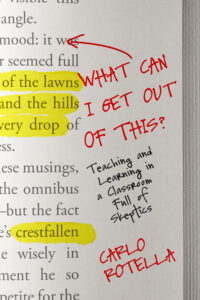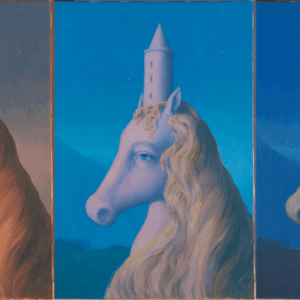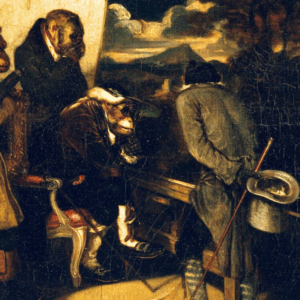
It’s Okay to Hate The House of Mirth
Carlo Rotella on Reading (and Learning) from Books We Dislike
What kind of reader does this book want me to be? When you start with this question, you’re taking a first step toward getting something meaningful out of whatever you read. Even if simply enjoying what you read is your objective, What kind of reader does this book—or poem, movie, game, song, newspaper, newscast, painting, website, social media stream, etc.—want me to be? offers a more promising place to start than Do I like this book? or What’s wrong with this book? and a much more promising place to start than Do I feel outraged or validated by this book?
Being outraged has increasingly become a default response for people who think of themselves as thinking persons, but it tends to shut down the mind rather than open it and so robs it of an opportunity to work and grow stronger and come to handle things with greater competence and find more joy in the encounter with them.
What kind of reader does this book want me to be? is useful precisely because it helps you find your way to meaning even when you dislike or hate or are outraged by a book. You can interrogate any reaction—like, dislike, disgust, fascination, irritation, bliss, boredom, hating or loving or identifying with a character, you name it—and exploit that reaction’s interpretive possibilities when you begin by thinking of the book as a machine that produces reactions in you and ask how the machine works.
The pearl, in this analogy, is an interpretive reading.
This is effective even if you fight the book every step of the way, reading against the grain of what it wants you to do, who it wants you to be. Actually, this approach may be even more effective when you naturally resist becoming the kind of reader a book wants you to be, because resisting its demands makes you acutely aware of them. When I teach literature courses, I tell students that genuine dislike of a book, or of something about a book, can function in the mind like a grain of sand that gets into an oyster, irritating the organism so much that it produces a pearl in response. The pearl, in this analogy, is an interpretive reading.
A teacher, too, can do something with strong responses, negative or positive. I bear in mind in this regard something that James Schamus, whom I interviewed for a magazine profile when he was the long-reigning head of the indie movie studio Focus Features, told me about CinemaScore exit polls of movie audiences. While an A from CinemaScore was always welcome, he said, “A B or B-minus is ‘eh.’ I’d rather have a C-minus or D, knowing that people have strong reactions.”
Which brings me to Edith Wharton’s The House of Mirth. As part of research for a book about what happens in the classroom, I interviewed at length the students who had taken the same required freshman literature course with me in the spring of 2020. When we discussed the books we had read, The House of Mirth took a beating.
“That was not my thing,” Susannah said, speaking for many. (I’ve changed the students’ names.) “The language, the time period.” The novel’s set in New York’s high society at the end of the nineteenth century—not that long ago—and its precise, elegant prose is by no means impenetrably alien, but there’s enough distance from us to trigger a response like Susannah’s.
Jonah, who told me that he finds it hard to sit still and read because he gets antsy very quickly, assumed an expression of vividly remembered pain as he said, with dripping irony, “That was so fun. Oh my gosh. A chapter of that would take me like an hour to get through, because I’m such a slow reader. And it’s just like, What the hell is this? What is she talking about?”
Dara, Eli, and Eva reported that reading The House of Mirth gave them flashbacks to bad experiences of being forced to read nineteenth-century novels in high-school English classes. Eva, with endearingly characteristic bluntness, told me, “I hated it. It was incredibly boring to me.” Dan, too: “Boring. Simple as that.”
The stakes couldn’t be higher because Lily apparently can’t function anywhere else than at the top of society. She’s a hothouse flower, and in the wrong conditions she’ll wither and die.
Among those who identified plot and character as the main off-putting traits, Charlotte articulated the response of several students when she explained, “I just couldn’t pinpoint what I wanted to talk about, what parts meant the most to me.” Tyler also couldn’t figure out how to care about what happened in the novel, but he could put his finger on the source of the problem: “I had just a harder time getting through that whole book because, like, all right, is she going to get married yet? Is she going to keep pushing all these guys away?”
He was referring to the main action of the novel, in which Lily Bart, low on capital but richly endowed with beauty and calculating acumen, tries to pick her way through a field of wealthy suitors. Each of them offers money and position but nothing much in the way of pleasure, excitement, intellectual stimulation, or the prospect of anything other than a life of loveless, socially irreproachable tedium possibly brightened by the occasional extramarital affair. She can’t bring herself to stomach any of the candidates or to say to hell with their money and hook up with the socially acceptable but modestly salaried lawyer Selden, to whom she might actually be attracted. The stakes couldn’t be higher because Lily apparently can’t function anywhere else than at the top of society. She’s a hothouse flower, and in the wrong conditions she’ll wither and die. But none of that mattered to Tyler.
Some students got into it. Arun said, “I think for me, coming from an Indian background, it wasn’t as alien to me because a lot of people have arranged marriages or, like, have that pressure of getting married.” Dave and Paul texted back and forth about Lily Bart’s suitors as they read, having fun with it, making a running joke of following her fortunes as if she were a contestant on The Bachelorette. “Can’t believe she’s really gonna pick Percy Gryce! I’m Team Selden all the way!” That game contained the seeds of an interpretive approach, to the extent that they recognized that there was a surprising and perhaps analytically exploitable bit of overlap between the kind of reader that The House of Mirth asked them to be and the kind of viewer The Bachelorette asked them to be.
Identifying or failing to identify with Lily, sympathizing with her or wishing she’d just hurry up and die already—students’ responses to the demands on them as readers exerted by The House of Mirth were all over the map, creating multiple pathways into the novel for us to exploit.
In class, when we talked about the language of the novel, we went deep on some tendencies we discerned in it during our initial noticing exercises: the narration makes a lot of word choices that have a resonance of business, war, predation, or science.
There’s constant talk of credit, speculation, interest, and capital in Wharton’s account of Lily Bart’s career in New York’s high-society marriage market. This language acquires an ironic edge when you consider that the women of the novel may have the lioness’s share of drive and ambition, but they’re shut out from Wall Street, where the plodding male characters enjoy copious access to money and power. So the female characters do their mergers, acquisitions, and other deal-making in the ballroom and boudoir. There’s also hunting and military imagery: “She began to cut the pages of a novel, tranquilly studying her prey through downcast lashes while she organized a method of attack.”
And there’s frequent recourse to the language of natural science: Lily’s compared to a “waterplant in the flux of the tides,” a “sea-anemone torn from the rock,” “spindrift on the whirling surface of existence,” a celestial body in eclipse as others rise above the horizon. She comes to perceive that “the blind motions of her mating-instinct . . . had been checked by the disintegrating influences of the life about her. All the men and women she knew were like atoms whirling away from each other in some wild centrifugal dance.”
Because our culture constantly urges them to develop interests and dreams and pursue them—that’s usually the essence of the essays they wrote to gain admission to college—acting on even the most impassioned impulse can feel like obeying orders from on high.
Seeking a larger pattern in the interplay of these different recurring veins of language, we made out a basic tension in the novel. Lily the entrepreneur-warrior-hunter may try to actively determine the course of her own life, but she’s also portrayed as passively in the tidal grip of large impersonal forces like money, desire, and different social rules for women and men.
Seeing how Lily is at once free to choose and helplessly locked into a life course created an analytical path along which even students initially put off by the novel might find their way into it. Lily’s older than they were, in her late twenties, and her marry-or-else situation might seem alien to most of them, but the larger questions Lily’s situation raises can seem more familiar. Do you feel like a warrior or a water plant? An entrepreneur or spindrift?
It’s often both at once, which can be disorienting in ways that students recognize. In both school and personal life, they have repeated occasion to wonder to what extent they’re authentically operating as free agents and to what extent they’re just going through the motions dictated by their programming and the demands of social class and the exclusive institutions and select groups to which they want to gain admittance. Because our culture constantly urges them to develop interests and dreams and pursue them—that’s usually the essence of the essays they wrote to gain admission to college—acting on even the most impassioned impulse can feel like obeying orders from on high. All of that resonates with the predicament of Lily Bart.
So now we’re talking less about language and more about plot, character, and theme, the other big category of reasons why many students found it hard to get into The House of Mirth. Many students balk at being asked to feel deeply about the tragedy of Lily’s ejection from her natural habitat of luxury, which the novel keeps showing and telling us she must have in order to feel that she’s truly living. She’s boxed in by sexual inequality in access to capital, mandatory marriage, and all the rest of the forces impinging on her, but at times it looks like the cause of her demise is low thread count. First-world problems, they say. Why is she so weak and whiny?
They needed each other’s help, not just mine, to get there.
I understand this kind of reaction. Even rereading it for the tenth time, I want to say to her, Look, if you have to marry and they’re all bozos, just pick the richest and most agreeable or malleable bozo and settle for the security he can provide, and you can emulate your high-society peers by having your romantic adventures on the side. Or marry Selden, if you’re actually attracted to him, and endure the not-very-unspeakable fate of being merely upper middle class rather than super-rich. Or don’t marry anybody and find your way into a bohemian tale or a proto-noir or a shopgirl story or some other formula. But don’t just stand there and dither until the world gets around to squashing you like a bug.
But that’s not really playing by the rules of the text. In this novel, it’s high society or nothing for Lily, a natural-born ditherer, and she’s too aware of the unjust strictures on her as a woman to allow herself to do what she has to do to assure her place in it. That should turn our attention to those strictures, rather than to questioning the verisimilitude of her melodramatic doom.
Many of my students got through The House of Mirth, and eventually got into it, only because it was assigned in a class for which they would be receiving credit and a grade. They needed each other’s help, not just mine, to get there.
Even Eli, who hated the book on sight, came around to it by way of class discussions. “This is the thing,” he told me. “I did not like it at first, but I thought the discussion we had about how the choices a character makes for relationships influence the idea of the narrative and the themes was very interesting at the end. And I’ve always had that mind-set in the back of my head since that book.”
If Eli came away from his encounter with The House of Mirth with a newly acquired habit of thinking about the character system as a way to figure out what a book’s about, then he got something useful out of it. And there’s extra value in the fact that his first reaction was negative but he pushed through it, was willing to consider what the book expected of him and why and how it produced that reaction, and didn’t settle for simply disliking the book. “But the book as a whole I did not like,” he added, with the air of a man setting the record straight.
Part of the value of teaching a text that students find offputting or otherwise not instantly likable is that it gives us a chance to practice a set of moves—identification, analogy, interrogating your own reactions to the text, putting your finger on how the form of the text encourages those reactions—they can employ when they find themselves put off by a book…or a movie, a painting, a song, a human being. Even the most broadly interested and forgiving person will react negatively to at least some books, and when it happens, it’s more important than ever to ask What kind of reader does this book want me to be?
__________________________________

What Can I Get Out of This?: Teaching and Learning in a Classroom Full of Skeptics by Carlo Rotella is available from University of California Press.
Carlo Rotella
Carlo Rotella's next book, forthcoming in spring 2019, is The World Is Always Coming to an End: Pulling Together and Apart in a Chicago Neighborhood. He is a professor of American Studies, Journalism, and English at Boston College. Rotella's new book is What Can I Get Out of This?: Teaching and Learning in a Classroom Full of Skeptics.












